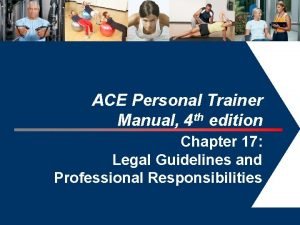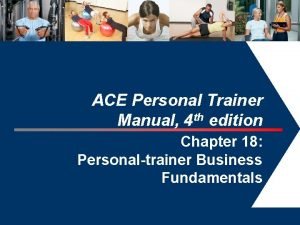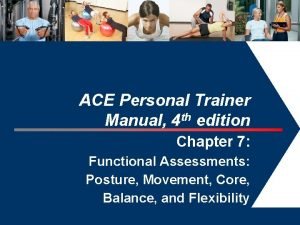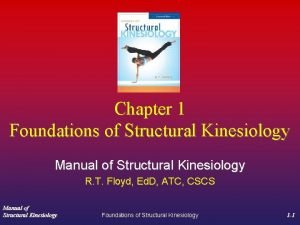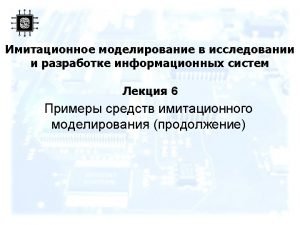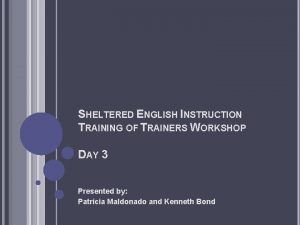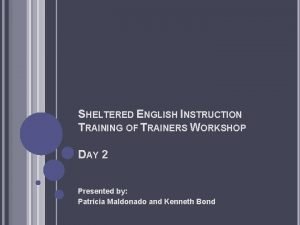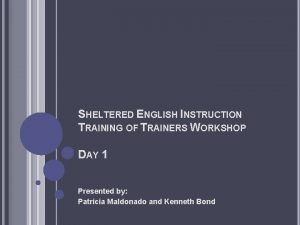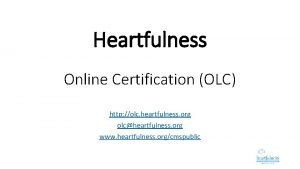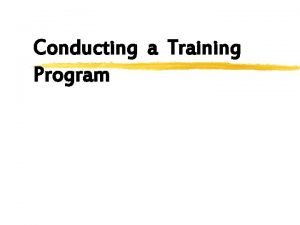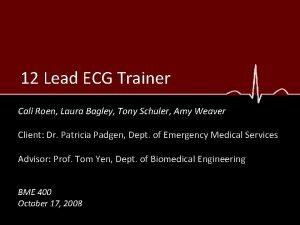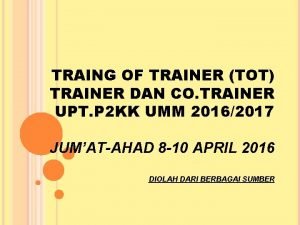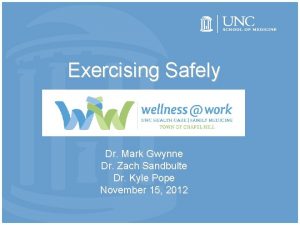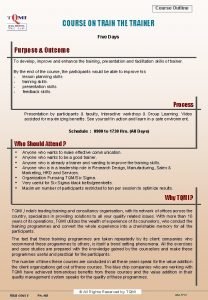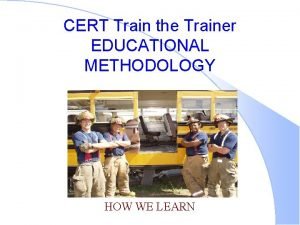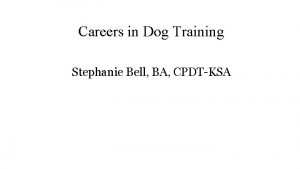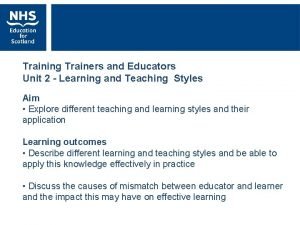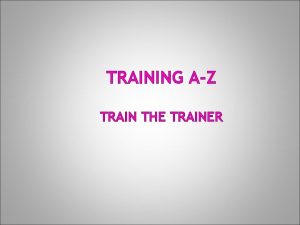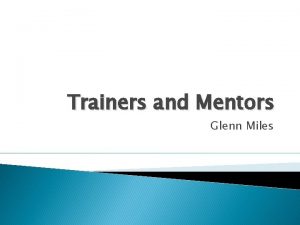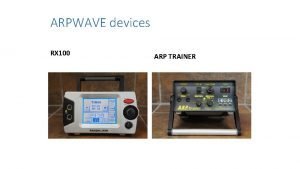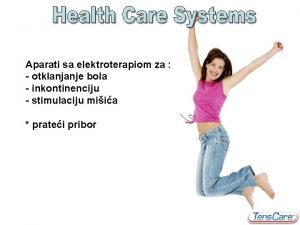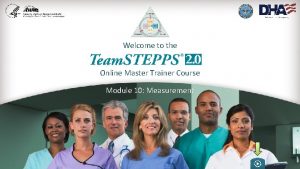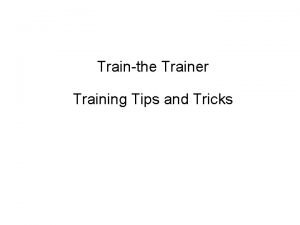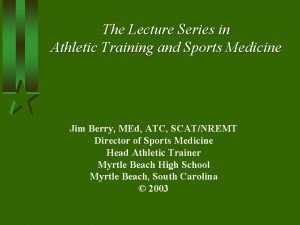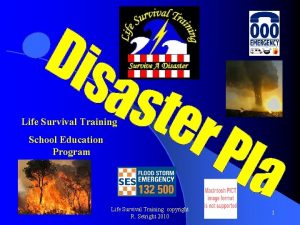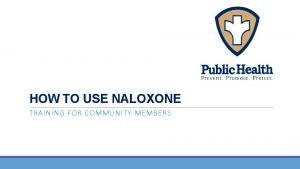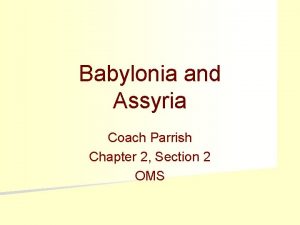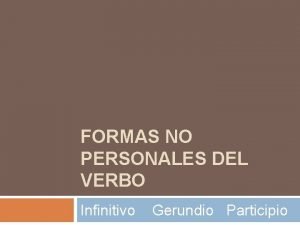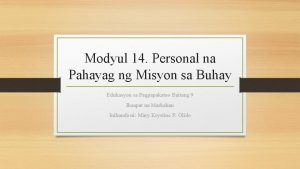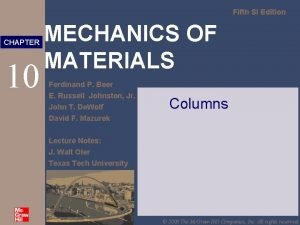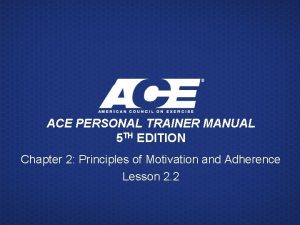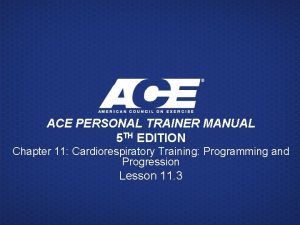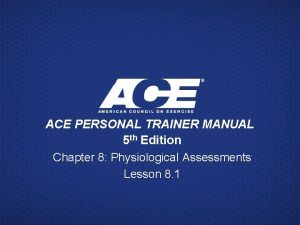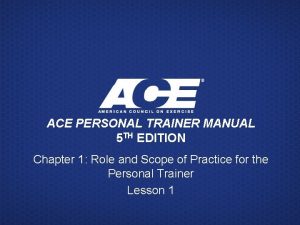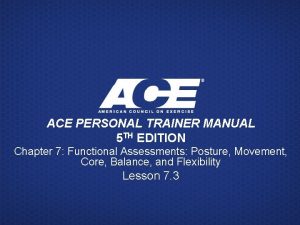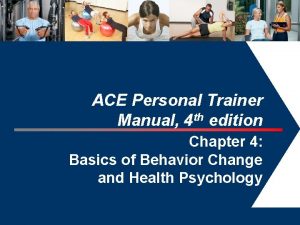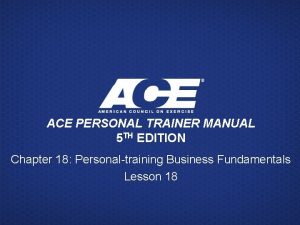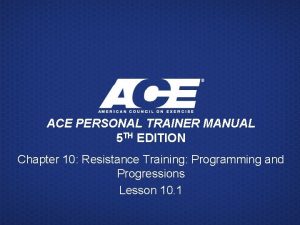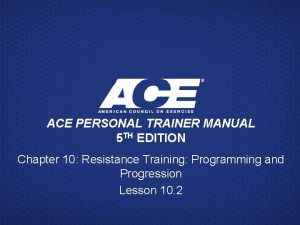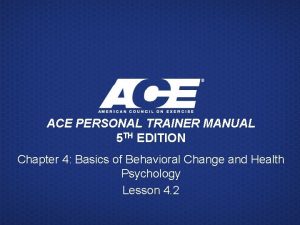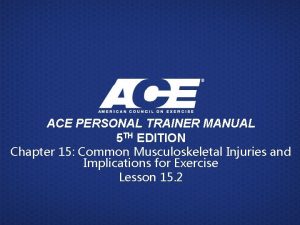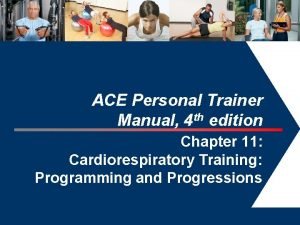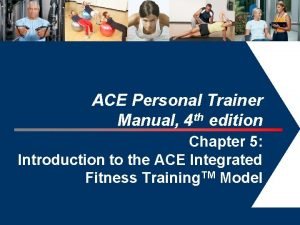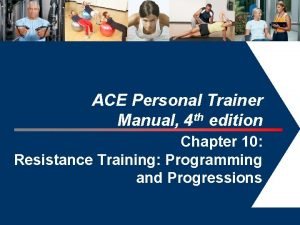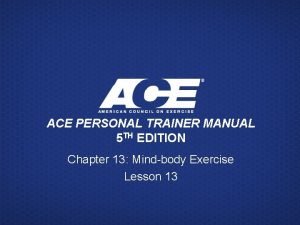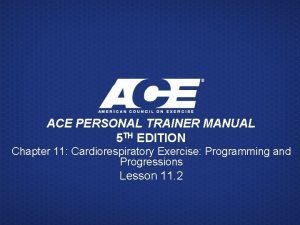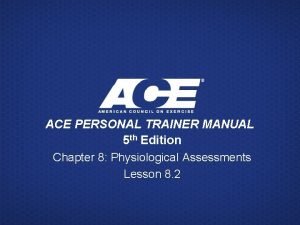ACE Personal Trainer Manual 4 th edition Chapter























































































- Slides: 87

ACE Personal Trainer Manual, 4 th edition Chapter 7: Functional Assessments: Posture, Movement, Core, Balance, and Flexibility 1

Learning Objectives § This session, which is based on Chapter 7 of the ACE Personal Trainer Manual (4 th ed. ), explains the importance of various functional assessments and outlines how to properly perform each. § After completing this session, you will have a better understanding of: – How to set up a plumb line to conduct a basic postural assessment. – How to identify five key postural deviations. – How to conduct various movement screens, including clearing tests. – How to conduct key flexibility (muscle-length) assessments. – How to evaluate balance and core function.

Introduction § Sequencing a client’s assessments involves consideration of protocol selection and timing of the assessments. § The physiological assessments must be consistent with the client’s goals and desires, and with the discoveries made during the needs assessment. § One primary objective of all training programs should be to improve functionality (movement efficiency).

Movement Efficiency § Movement efficiency is the ability to generate appropriate levels of force and movement at desired joints while stabilizing the entire kinetic chain against reactive and gravity-based forces. – All movement begins and ends from a static base, ideally a position where all body segments are optimally aligned. – Since movement originates from this base, a postural assessment should be conducted to evaluate body-segment alignment. – Additionally, movement screens that evaluate how posture impacts the ability to move should be incorporated.

Static Posture § Static posture represents the alignment of the body’s segments. – Holding a proper postural position involves the actions of postural muscles. § Good posture is a state of musculoskeletal alignment that allows muscles, joints, and nerves to function efficiently. – If a client exhibits poor static posture, this may reflect muscleendurance issues in the postural muscles and/or potential imbalances at the joints. § Since movement begins from a position of static posture, the presence of poor posture is an indicator that movement may be dysfunctional.

Static Postural Assessment § A static postural assessment may offer valuable insight into: – Muscle imbalance at a joint and the working relationships of muscles around a joint – Altered neural action of the muscles moving and controlling the joint – Potentially dysfunctional movement § Tight or shortened muscles are often overactive and dominate movement at the joint, potentially disrupting healthy joint mechanics. – Personal trainers should consider conducting a static postural assessment on their clients as an initial assessment.

Muscle Imbalance and Postural Deviation Factors § Muscle imbalance and postural deviations can be attributed to many factors that are both correctible and non-correctible. § Correctible factors: – Repetitive movements – Awkward positions and movements – Side dominance – Lack of joint stability or mobility – Imbalanced strength-training programs § Non-correctible factors: – Congenital conditions – Some pathologies – Structural deviations – Certain types of trauma

Neural Activity § Proper postural alignment promotes optimal neural activity of the muscles controlling a joint. – When joints are correctly aligned, the length-tension relationships and force-coupling relationships function efficiently. – Good posture facilitates proper joint mechanics. Muscle Balance Normal Length-Tension Relationship Normal Force-coupling Relationships Proper Joint Mechanics (Arthrokinematics) Efficient Force Acceptance and Generation Movement Efficiency Promotes Joint Stability and Joint Mobility

Right-angle Rule of the Body § An initial training focus should be to restore stability and mobility and attempt to “straighten the body before strengthening it. ” – The trainer should start by looking at a client’s static posture following the right-angle rule of the body. – This model portrays the human body in vertical alignment across the major joints. § The right-angle rule allows the observer to look at the individual in all three planes to note specific “static” asymmetries at the joints, as illustrated on the following slide.

Right-angle Rule (Frontal and Sagittal Views)

Line of Gravity § Good posture is observed when the body parts are symmetrically balanced around the body’s line of gravity. – While the right-angle rule can identify potential muscle imbalances, there are limitations in using this model. Line of Gravity

Plumb Line Instructions § The objective of this assessment is to observe the client’s symmetry against the plumb line. – Using a length of string and an inexpensive weight, trainers can create a plumb line that suspends from the ceiling to a height 0. 5 to 1 inch (1. 3 to 2. 5 cm) above the floor. – A solid, plain backdrop or a grid pattern with vertical and horizontal lines that offer contrast against the client is recommended. – Clients should assume a normal, relaxed position. – Personal trainers should focus on the obvious, gross imbalances and avoid getting caught up in minor postural asymmetries.

Plumb Line Positions: Anterior View § For the anterior view, position the client between the plumb line and a wall. § With good posture, the plumb line will pass equidistant between the feet and ankles, and intersect the: – Pubis – Umbilicus – Sternum – Manubrium – Mandible (chin) – Maxilla (face) – Frontal bone (forehead)

Plumb Line Positions: Posterior View § For the posterior view, position the individual between the plumb line and a wall. – With good posture, the plumb line should ideally intersect the sacrum and overlap the spinous processes of the spine.

Plumb Line Positions: Sagittal/Transverse Views § Position the individual between the plumb line and the wall, with the plumb line aligned immediately anterior to the lateral malleolus. § With good posture, the plumb line should ideally pass through: – The anterior third of the knee – The greater trochanter of the femur – The acromioclavicular (A-C) joint – Slightly anterior to the mastoid process of the temporal bone of the skull § All transverse views of the limbs and torso are performed from frontal- and sagittal-plane positions.

Chronological Plan for Conducting Assessments § When conducting assessments of posture and movement, the following components should be considered. Health History and Lifestyle Information Static Postural Assessment Identify Correctible Postural Compensations Documentation and Determination of Need for Referral to Medical Professional Muscle Length Testing – Active and Passive ROM Administer Appropriate Movement Screens Restorative Exercise Stability and Mobility Programming Movement Training Progression Load Training Performance Training

Deviation 1: Ankle Pronation/Supination § Both feet should face forward in parallel or with slight (8 to 10 degrees) external rotation. – Toes pointing outward from the midline, as the ankle joint lies in an oblique plane with the medial malleolus slightly anterior to the lateral malleolus § The toes should be aligned in the same direction as the feet.

Ankle Pronation and Tibial and Femoral Rotation § The body is one continuous kinetic chain. § Barring structural differences in the skeletal system, a pronated ankle typically forces internal rotation of the tibia and faster, greater internal rotation of the femur.

Ankle Pronation/Supination: Lower Extremity Effects § Ankle pronation forces rotation at the knee and places additional stresses on the knee. – As pronation moves the calcaneus into eversion, this may actually lift the outside of the heel slightly off the ground. – In turn, this may tighten the calf muscles and potentially limit ankle dorsiflexion. – A tight gastrocnemius and soleus complex (triceps surae) may force calcaneal eversion in an otherwise neutral subtalar joint position.

Deviation 2: Hip Adduction § Hip adduction is a lateral tilt of the pelvis that elevates one hip higher than the other. – If a person raises the right hip, the line of gravity following the spine tilts toward the left following the spine. – This position progressively lengthens and weakens the right hip abductors, which are unable to hold the hip level. – Sleeping on one’s side can produce a similar effect, as the hip abductors of the upper hip fail to hold the hip level.

Alignment of the Pelvis Relative to the Plumb Line § To evaluate the presence of hip adduction with a client, a personal trainer must identify the alignment of the pelvis relative to the plumb line.

Hip Adduction Screen § The plumb line should pass through: – The pubis in the anterior view – The middle of the sacrum in the posterior view § Positioning a dowel or lightly weighted bar across the iliac crests can help determine whether the iliac crests are parallel with the floor.

Deviation 3: Hip Tilting (Anterior or Posterior) § Anterior tilting of the pelvis frequently occurs in individuals with tight hip flexors. – With standing, a shortened hip flexor pulls the pelvis into an anterior tilt. – An anterior pelvic tilt rotates the superior, anterior portion of the pelvis forward and downward. – A posterior tilt rotates the superior, posterior portion of the pelvis backward and downward.

Pelvic Rotation § An anterior pelvic tilt will increase lordosis in the lumbar spine, whereas a posterior pelvic tilt will reduce the amount of lordosis in the lumbar spine. – Tight hip flexors are generally coupled with tight erector spinae muscles, producing an anterior pelvic tilt. – Tight rectus abdominis muscles are generally coupled with tight hamstrings, producing a posterior pelvic tilt. – This coupling relationship between tight hip flexors and erector spinae is defined as the lower-cross syndrome. – With ankle pronation and accompanying internal femoral rotation, the pelvis may tilt anteriorly to better accommodate the head of the femur.

Pelvic Tilt Screen: ASIS and PSIS § To evaluate the presence of a pelvic tilt, a trainer can use a consensus of four techniques: – The relationship of the anterior superior iliac spine (ASIS) and the posterior superior iliac spine (PSIS) (two bony landmarks on the pelvis) – The appearance of lordosis in the lumbar spine – The alignment of the pubic bone to the ASIS – The degree of flexion or hyperextension in the knees

Deviation 4: Shoulder Position and Thoracic Spine § Limitations and compensations to movement at the shoulder occur frequently due to the complex nature of the shoulder girdle. – Observation of the scapulae in all three planes provides good insight into the quality of movement a client has at the shoulders. – Locate the normal “resting” position of the scapulae

Shoulder Screen: Level Shoulders § Determine whether the shoulders are level. – If the shoulders are not level, trainers need to identify potential reasons.

Shoulders: Torso/Shoulders Relative to Line of Gravity § Determine whether the torso and shoulders are symmetrical relative to the line of gravity. – A torso lean would shift the alignment of the sternum and spine away from the plumb line and create tightness on the flexed side of the trunk. – However, if the hips are level with the floor and the spine is aligned with the plumb line, but the shoulders are not level with the floor, this may represent muscle imbalance within the shoulder complex itself. – An elevated shoulder may present with an overdeveloped or tight upper trapezius muscle. – A depressed shoulder may present with more forward rounding of the scapula. – The shoulder on a person’s dominant side may hang lower than the non -dominant side.

Shoulders: Rotation of the Scapulae and/or Arms § Determine whether the scapulae and/or arms are internally rotated. § Anterior view – If the knuckles or the backs of the client’s hands are visible when the hands are positioned at the sides, this generally indicates internal rotation of the humerus or scapular protraction. § Posterior view – If the vertebral/inferior angles of the scapulae protrude outward, it indicates an inability of the scapulae stabilizers to hold the scapulae in place.

Shoulders: Normal Kyphosis § Determine whether the spine exhibits normal kyphosis. – With the client’s consent, the trainer can run one hand gently up the thoracic spine between the scapulae. – The spine should exhibit a smooth, small, outward curve.

Deviation 5: Head Position § With good posture, the earlobe should align approximately over the acromion process. § A forward-head position is very common. – This altered position does not tilt the head downward, but simply shifts it forward. – The earlobe appears significantly forward of the acromioclavicular (AC) joint.

Forward-head Position Screen § In the sagittal view, align the plumb line with the AC joint, and observe its position relative to the ear. § A forward-head position represents tightness in the cervical extensors and lengthening of the cervical flexors. § With good posture, the cheek bone and the collarbone should almost be in vertical alignment with each other.

Movement Screens § Observing active movement is an effective method to identify movement compensations. § When compensations occur, it is indicative of altered neural action. § These compensations normally manifest due to muscle tightness or an imbalance between muscles acting at the joint.

Five Primary Movements § Movement can essentially be broken down and described by five primary movements that people perform during many daily activities: – Bending/raising and lifting/lowering movements (e. g. , squatting) – Single-leg movements – Pushing movements – Pulling movements – Rotational movements § ADL are essentially the integration of one or more of these primary movements.

Movement Screens and the Kinetic Chain § Movement screens must be skill- and conditioning-level appropriate, and be specific to the client’s needs. – Screens generally challenge clients with no recognized pathologies to perform basic movements. – This can help the personal trainer evaluate a client’s stability and mobility throughout the entire kinetic chain.

Clearing Tests § Prior to administering any movement screens, trainers should screen for pain by using basic clearing tests. – These tests may uncover issues that the individual did not know existed. – Trainers should select clearing tests according to the movements that require evaluation. – The objective when conducting clearing tests is to ensure that pain is not exacerbated by movement. § Any client who exhibits pain during a clearing test should: – Be referred to his or her physician – Not perform additional assessments for that part of the body

Clearing Test: Cervical Spine § The client performs the following movements in a seated position while the personal trainer monitors for any indication of pain: – Move the chin to touch the chest. – Tilt the head back until the face lies approximately parallel or near parallel to the floor. – Drop the chin left and right to rest on, or within 1 inch (2. 5 cm) of, the shoulder or collarbone.

Clearing Test: Shoulder Impingement § The client performs the following movement in a seated position while the personal trainer monitors for any indication of pain: – Reach one arm across the chest to rest upon the opposite shoulder and slowly elevate the elbow as high as possible.

Clearing Test: Low Back § The client performs the following movements from a prone position while the personal trainer monitors for any indication of pain: – Slowly move into a trunk-extension position, producing lumbar extension and compression in the vertebrae and shoulder joint. – Move into a quadruped position and slowly sit back on the heels with outstretched arms, producing lumbar and hip flexion.

Bend and Lift Screen: Objective § To examine symmetrical lower-extremity mobility and stability, and upper-extremity stability during a bend-andlift movement

Bend and Lift Screen: Frontal View Observations § First repetition – Observe the stability of the foot. § Second repetition – Observe the alignment of the knees over the second toe. § Third repetition – Observe the overall symmetry of the entire body over the base of support.

Bend and Lift Screen: Sagittal View Observations § First repetition – Observe whether the heels remain in contact with the floor. § Second repetition – Determine whether the client exhibits “glute” or “knee” dominance. § Third repetition – Observe whether the client achieves a parallel position between the tibia and torso in the lowered position, while controlling the descent phase. § Fourth repetition – Observe the degree of lordosis in the lumbar/thoracic spine during lowering and in the lowered position. § Fifth repetition – Observe any changes in head position.

Bend and Lift Screen: Potential Compensations

Hurdle Step Screen: Objective § To examine simultaneous mobility of one limb and stability of the contralateral limb while maintaining both hip and torso stabilization under a balance challenge of standing on one leg

Hurdle Step Screen: Frontal View Observations § First repetition – Observe the stability of the foot. § Second repetition – Observe the alignment of the stance-leg knee over the foot. § Third repetition – Watch for excessive hip adduction greater than 2 inches (5. 1 cm) as measured by excessive stance-leg adduction or downward hip-tilting toward the opposite side. § Fourth repetition – Observe the stability of the torso. § Fifth repetition – Observe the alignment of the moving leg.

Hurdle Step Screen: Sagittal View Observations § First repetition – Observe the stability of the torso and stance leg. § Second repetition – Observe the mobility of the hip.

Hurdle Step Screen: Potential Compensations

Shoulder Push Stabilization Screen: Objective § To examine stabilization of the scapulothoracic joint during closed-kinetic-chain pushing movements

Shoulder Push Stabilization Screen: Observations § Observe any notable changes in the position of the scapulae relative to the ribcage at both end-ranges of motion. § Observe for lumbar hyperextension in the press position.

Should Push Screen: Potential Compensations

Shoulder Pull Stabilization Screen: Objective § To examine the client’s ability to stabilize the scapulothoracic joint during closed-kinetic-chain pulling movements

Shoulder Pull Stabilization Screen: Observations § Observe any bilateral discrepancies between the pulls on each arm. § Observe the ability to stabilize the trunk during the pull movement. – That is, the ability of the core to stiffen and lift the hips with the shoulders and resist trunk rotation during the lift.

Shoulder Pull Screen: Potential Compensations

Thoracic Spine Mobility Screen: Objective § To examine bilateral mobility of the thoracic spine § Lumbar spine rotation is considered insignificant, as it only offers approximately 15 degrees of rotation.

T-Spine Mobility Screen: General Interpretations § Observe any bilateral discrepancies between the rotations in each direction. – Identify the origin(s) of movement limitation or compensation. – This screen evaluates trunk rotation in the transverse plane. – Evaluate the impact on the entire kinetic chain. – The lumbar spine generally exhibits limited rotation of approximately 15 degrees, with the balance of trunk rotation occurring through the thoracic spine. – If thoracic spine mobility is limited, the body strives to gain movement in alternative planes within the lumbar spine.

Thoracic Spine Screen: Potential Compensations

Flexibility and Muscle-length Testing § A personal trainer may opt to assess the flexibility of specific muscle groups. § Specific muscle groups that frequently demonstrate tightness or limitations to movement are discussed in this section. § The table on the following slide provides normal ranges of motion for healthy adults at each joint.

Average Ranges of Motion

Thomas Test—Hip Flexion/Quad Length: Objective § To assess the length of the muscles involved in hip flexion – This test should not be conducted on clients suffering from lowback pain, unless cleared by their physician.

Thomas Test—Hip Flexion/Quad Length: Observations § Observe whether the back of the lowered thigh touches the table (hips positioned in 10 degrees of extension). § Observe whether the knee of the lowered leg achieves 80 degrees of flexion. § Observe whether the knee remains aligned straight or falls into internal or external rotation.

Thomas Test: General Interpretations

Passive Straight-leg (PSL) Raise: Objective § To assess the length of the hamstrings

Passive Straight-leg (PSL) Raise: Observations § Note the degree of movement attained from the table or mat that is achieved before the spine compresses the hand under the low back or the opposite leg begins to show visible signs of lifting off the table or mat. – The mat or table represents 0 degrees. – The leg perpendicular to the mat or table represents 90 degrees.

Passive Straight-leg Raise: General Interpretations

Shoulder Mobility Assessment § Apley’s scratch test involves multiple and simultaneous movements of the scapulothoracic and glenohumeral joints in all three planes. – To identify the source of the limitation, trainers can first perform various isolated movements in single planes to locate potentially problematic movements. § Consequently, the scratch test is completed in conjunction with: – The shoulder flexion-extension test – An internal-external rotation test of the humerus

Apley’s Scratch Test—Shoulder Mobility: Objective § To assess simultaneous movements of the shoulder girdle (primarily the scapulothoracic and glenohumeral joints) § Movements include: – Shoulder extension and flexion – Internal and external rotation of the humerus at the shoulder – Scapular abduction and adduction

Apley’s Scratch Test—Shoulder Mobility: Observations § Note the client’s ability to touch the medial border of the contralateral scapula or how far down the spine he or she can reach with shoulder flexion and external rotation. § Note the client’s ability to touch the opposite inferior angle of the scapula or how far up the spine he or she can reach with shoulder extension and internal rotation. § Observe any bilateral differences between the left and right arms in performing both movements.

Apley’s Scratch: General Interpretations

Shoulder Flexion Test: Objective § To assess the degree of shoulder flexion – This test should be performed in conjunction with Apley’s scratch test to determine if the limitation occurs with shoulder flexion or extension.

Shoulder Extension Test: Objective § To assess the degree of shoulder extension – This test should be performed in conjunction with Apley’s scratch test to determine if the limitation occurs with shoulder flexion or extension.

Shoulder Flexion/Extension Tests: Observations § Measure the degree of movement in each direction. § Note any bilateral differences between the left and right arms in performing both movements.

Shoulder Flexion/Extension: General Interpretations

External Rotation—Humerus (Shoulder): Objective § To assess external rotation of the humerus at the shoulder joint to evaluate medial rotators – This test should be performed in conjunction with Apley’s scratch test to determine if the limitation occurs with internal or external rotation of the humerus.

Internal Rotation—Humerus (Shoulder): Objective § To assess internal rotation of the humerus at the shoulder joint to evaluate lateral rotators – This test should be performed in conjunction with Apley’s scratch test to determine if the limitation occurs with internal or external rotation of the humerus.

Internal/External Rotation—Humerus: Observations § Measure the degree of movement in each direction. § Note any bilateral differences between the left and right arms in performing both movements.

Internal/External Rotation—Humerus: Interpretation

Balance and the Core § Balance and core baseline assessments evaluate the need for comprehensive balance training and core conditioning. § Dynamic balance tests are generally movement-specific and quite complex. – Trainers should aim to first evaluate the basic level of static balance that a client exhibits by using the sharpened Romberg test or the stork-stand test.

Sharpened Romberg Test: Objective § To assess static balance by standing with a reduced base of support while removing visual sensory information

Sharpened Romberg Test: Observations § Continue to time the client’s performance until one of the following occurs: – The client loses postural control and balance – The client’s feet move on the floor – The client’s eyes open – The client’s arms move from the folded position – The client exceeds 60 seconds with good postural control

Sharpened Romberg Test: General Interpretations § The client needs to maintain his or her balance with good postural control (without excessive swaying) and not exhibit any of the test-termination criteria for 30 or more seconds. § The inability to reach 30 seconds is indicative of inadequate static balance and postural control.

Stork-stand Balance Test: Objective § To assess static balance by standing on one foot in a modified stork-stand position

Stork-stand Balance Test: Observations § Timing stops when any of the following occurs: – The hand(s) come off the hips – The stance or supporting foot inverts, everts, or moves in any direction – Any part of the elevated foot loses contact with the stance leg – The heel of the stance leg touches the floor – The client loses balance

Stork-stand Balance Test: General Interpretation

Core Function—BP Cuff Test: Objective § To assess core function, as demonstrated by the ability to draw the abdominal wall inward via the coordinated action of the transverse abdominis (TVA) and related core muscles without activation of the rectus abdominis

Core Function—BP Cuff Test: Observations § While the client attempts the contraction, carefully monitor for any movement of the hips, ribcage, or shoulders. § Clients must avoid any movement at the ankles (dorsiflexion) or pushing from the elbows that would be used as leverage to raise the torso.

Core Function—BP Cuff Test: General Interpretation § A good indicator of TVA function is the ability to reduce the pressure in the cuff by 10 mm. Hg during the contraction. – If a client lacks effective core function, he or she usually recruits the rectus abdominis muscle instead to achieve the desired movement. – No change or a change <10 mm. Hg does not necessarily represent a lack of core function.

Summary § Trainers should adhere to the principle of “straightening the body before strengthening it. ” § Trainers should consider performing the assessments in Chapter 7 of the ACE Personal Trainer Manual (4 th ed. ), in the sequence presented. § This session covered: – Static postural assessment – Movement screens – Flexibility and muscle-length testing – Shoulder mobility assessment – Balance and the core
 Scope of practice personal trainer
Scope of practice personal trainer Personal trainer swot analysis
Personal trainer swot analysis Engineering economy 16th edition chapter 5 solutions
Engineering economy 16th edition chapter 5 solutions Engineering economy 16th edition solution manual chapter 5
Engineering economy 16th edition solution manual chapter 5 Engineering economy 16th edition solution
Engineering economy 16th edition solution Ace personal training
Ace personal training Using mis (10th edition) 10th edition
Using mis (10th edition) 10th edition Mis
Mis Manual of structural kinesiology 18th edition
Manual of structural kinesiology 18th edition Chapter 8 personal finance
Chapter 8 personal finance Anylogic personal learning edition
Anylogic personal learning edition Good trainer qualities
Good trainer qualities Train the trainer objectives
Train the trainer objectives Luke trainer clark the boy who cried wolf
Luke trainer clark the boy who cried wolf Sheltered trainers
Sheltered trainers Sheltered trainers
Sheltered trainers Sheltered trainers
Sheltered trainers Cisco certified instructor
Cisco certified instructor My csudh portal
My csudh portal Mct enrollment tool
Mct enrollment tool Azure certification poster
Azure certification poster Heartfulness.org login
Heartfulness.org login Good trainer qualities
Good trainer qualities Example of malfeasance in athletic training
Example of malfeasance in athletic training Dr laura bagley
Dr laura bagley Huet simulator
Huet simulator Siemens cooperates with education
Siemens cooperates with education Microsoft innovative educator trainer academy
Microsoft innovative educator trainer academy Vad är en argumenterande text
Vad är en argumenterande text Co trainer adalah
Co trainer adalah Globe trainer
Globe trainer Zach morgan trainer
Zach morgan trainer Free diastat trainer
Free diastat trainer Train the trainer training program outline
Train the trainer training program outline Cert train the trainer
Cert train the trainer Self-employed dog trainer salary
Self-employed dog trainer salary Sheltered 2 trainer
Sheltered 2 trainer Train the trainer agenda
Train the trainer agenda Qualities of a good trainer
Qualities of a good trainer Nebuchadnezzar trainer
Nebuchadnezzar trainer Trainer profile
Trainer profile Green world group abu dhabi
Green world group abu dhabi The messenger trainer
The messenger trainer Step trainer
Step trainer Arp trainer
Arp trainer Reinov sindrom
Reinov sindrom Translator
Translator Teamstepps master trainer
Teamstepps master trainer Trainthe trainer
Trainthe trainer Trainer evaluation criteria
Trainer evaluation criteria The flame in the flood trainer
The flame in the flood trainer Schulungsdokumentation
Schulungsdokumentation Nexplanon lawrence
Nexplanon lawrence Narcan trainer
Narcan trainer Charles peloquin trainer
Charles peloquin trainer The athletic trainer is most directly responsible
The athletic trainer is most directly responsible Gait trainer gt1
Gait trainer gt1 Stone avenue train station
Stone avenue train station Lifez - survival trainer
Lifez - survival trainer Athletic trainer liability
Athletic trainer liability Nasal narcan trainer
Nasal narcan trainer Leave no trace boy scouts
Leave no trace boy scouts Nebuchadnezzar trainer
Nebuchadnezzar trainer Master trainer 45
Master trainer 45 Verboides infinitivos
Verboides infinitivos Adivinanzas sobre la higiene personal
Adivinanzas sobre la higiene personal Ang aking pahayag ng personal na misyon sa buhay
Ang aking pahayag ng personal na misyon sa buhay Organizational behavior 18th edition
Organizational behavior 18th edition Organic chemistry (3rd) edition chapter 1 problem 16s
Organic chemistry (3rd) edition chapter 1 problem 16s Beer johnston
Beer johnston Mechnaines of material chapter 7 answer
Mechnaines of material chapter 7 answer Mechanics of materials chapter 6 solutions
Mechanics of materials chapter 6 solutions Mechanics
Mechanics Mechanics of materials chapter 10 solutions pdf
Mechanics of materials chapter 10 solutions pdf Everything's an argument 8th edition chapter 1 summary
Everything's an argument 8th edition chapter 1 summary Chapter 6 portable fire extinguishers
Chapter 6 portable fire extinguishers Engineering economy 16th edition chapter 4 solutions
Engineering economy 16th edition chapter 4 solutions Business essentials 12th edition chapter 1
Business essentials 12th edition chapter 1 Psychology ciccarelli 5th edition chapter 1
Psychology ciccarelli 5th edition chapter 1 Prehospital emergency care 11th edition
Prehospital emergency care 11th edition Do role requirements change in different situations
Do role requirements change in different situations Organic chemistry third edition david klein
Organic chemistry third edition david klein Landmark in humanities 5th edition
Landmark in humanities 5th edition Infant child and adolescent berk 8th edition chapter 1
Infant child and adolescent berk 8th edition chapter 1 Mechanic of materials
Mechanic of materials Mechanics of materials 6th edition solutions chapter 9
Mechanics of materials 6th edition solutions chapter 9 Adler and rodman 2006
Adler and rodman 2006 Business essentials 12th edition answer key
Business essentials 12th edition answer key
